Published by The History Press
Charleston, SC
www.historypress.com
Copyright 2019 by Lawrence R. Samuel
All rights reserved
Cover image is hand-colored postcard of Tudor Citys south park, circa 1930s.
First published 2019
E-book edition 2019
ISBN 978.1.43966.823.8
Library of Congress Control Number: 2019945091
Print edition ISBN 978.1.46714.392.9
Notice: The information in this book is true and complete to the best of our knowledge. It is offered without guarantee on the part of the author or The History Press. The author and The History Press disclaim all liability in connection with the use of this book.
All rights reserved. No part of this book may be reproduced or transmitted in any form whatsoever without prior written permission from the publisher except in the case of brief quotations embodied in critical articles and reviews.
INTRODUCTION
Its popularity with New Yorkers has not faltered over the decades.
Tudor City Historic District Designation Report, 1988
The next time youre in New York City, walk east a few blocks from Grand Central Station along 42nd Street, take the stairs near the Church of the Covenant and voila!youve entered another world. Tudor Citythe five-acre faux medieval village, albeit with high-rise apartment buildings is on the far east side of midtown Manhattan between First and Second Avenues and 40th and 43rd Streets, right around the corner from the United Nations. Tudor City is not just the architectural masterpiece created by real estate developer Fred F. French and the first residential skyscraper complex in the world; its a unique community that has played a significant role in the history of New York City over nearly the past century. The story of the city within a city, as it quickly became known, tells us much about life in Manhattan since the late 1920s, when the development came into being.
Beyond its sheer sizeimmense for its timeTudor City set a pattern for urban residential development by creating from scratch what was designed to be an essentially self-sustaining community. While other neighborhoods in Manhattan had been recently gentrified, none rivaled the scope and magnitude of Tudor City and its grand ambition to offer residents a refuge from intensifying urbanization. Additionally, the ways in which money was raised to build Tudor City were unprecedented in the 1920s, and this also made the complex an important milestone in the history of real estate development. Tudor City has not only served as a key site of New York City (and New York State) history but, even more importantly, has also been a major part of the lives of the many thousands of people (including myself) who have spent time there. Telling the full story of Tudor City thus reveals fascinating, largely unknown insights about New York City and about real-life individuals who have called the place home through the decades right up to today.
Not surprisingly, much of the story of Tudor City revolves around the value of land in New York City. Real estate in Manhattan is a universe unto its own, as any New Yorker can (and will) tell you, with the land under Tudor City no exception. The area served as a much-contested site in the 1970s and 1980s, with developers and preservationists fiercely battling it out on the streets and in the courts. A notable cast of charactersincluding Governor Nelson Rockefeller, Mayor John Lindsay and Representative Ed Kochentered the fray, with developer extraordinaire Harry Helmsley ably playing the role of villain. (His rival in real estate, one Donald J. Trump, makes a cameo appearance.) Most notably, perhaps, Tudor City was an early example of urban renewal, Garden City Planning and new urbanism, a big reason why it was named a historic district by the citys Landmarks Preservation Commission in 1988. For years to come, Tudor City would serve as a major influence in architecture and design across the country (the commission even deemed it prophetic) and presage the recent movement toward more walkable and greener communities. Tudor City is a landmark in New Yorks physical history, Eugene Rachlis and John E. Marqusee noted in their 1963 The Land Lords, having spurred one of the most dramatic shifts in the direction of the city.
In some ways, the history of Tudor City can be viewed as a microcosm of the history of New York City itself. As the city went through the normal highs and lows of the economic cycle, so did Tudor City; the developments occupancy rate and rent prices (and later co-op values) were directly tied to the relative health of the local housing market. The key economic, political and social factors that shaped the nation in the twentieth centurymost notably the Great Depression, World War II, the Cold War and the fiscal crisis of the 1970swere also instrumental in steering the course of Tudor City. While thus an urban oasis, a sanctuary in the storm that was New York City, Tudor City was at the same time indelibly connected to events taking place in the city, the nation and often the world.
To that point, one major theme that emerges in the telling of the story of Tudor City is the efforts taken by its residents to protect the community from outside forces that were perceived as a threat. From the very beginnings of the development, in fact, those who chose Tudor City as a place to live were keenly aware of the specialness of the community, specifically how it was not just a city within a city but a kind of island on an island. Starting with the arrival of the United Nations around midcentury through the end of the reign of Harry Helmsley in the mid-1980s, tenants waged an almost continual battle to preserve the character and, sometimes, the very land underneath Tudor City. Residents, especially members of the Tudor City Tenants Association, led by John McKean, were a feisty bunch and not afraid to go head to head with whomever was attempting to take something away from the community or alter its unique chemistry. Because of its insulation, it was easy to see why the rich and powerful considered expanding it, establishing residence right next to it and perhaps even acquiring it for their own purposes. The fear that something vastly bigger and more modern would spring up in the shadow of Tudor City was a persistent one, fueling the activist spirit that was and remains an integral part of the communitys DNA.
The willingness for a band of Davids to take on Goliaths was the most extreme evidence of the strong communitarian nature of Tudor City. Although in the big scheme of things the stakes cannot be said to have been largemost often the fate of a pair of small parksthe years of political and legal wrangling brought into high relief some major civic issues (e.g., public versus private interests, progress versus quality of life and development versus preservation). Support for Tudor City was bipartisan, I might add, a wonderful thing to see given todays deeply divided political climate. In some respects, Tudor City blazed the trail of major apartment building complexes in New York City, its years of litigation paying off future dividends by clarifying what developers could and could not do. Noise and air pollution coming from the nearby Con Ed plant were a frequent source of angst for residents but also served as a central rallying point that brought neighbors closer together. Tudor City can be said to have been ahead of its time in this regard as well, anticipating the environmental movement of today and the emergence of green politics all around the world.


















